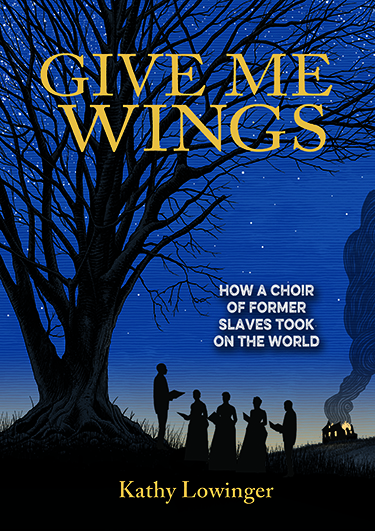| ________________
CM . . .
. Volume XXII Number 15. . . .December 11, 2015
excerpt:
Give Me Wings is a nonfiction book that depicts the history of slavery in the United States. While the book’s theme focuses on the important role education plays in driving change, it is uniquely presented through the lens of music and the power of language through song to influence long-established attitudes. It offers a fresh perspective on slavery and prejudice that results in an engaging and informative read. The book opens in the 1800s during the time of the American Civil War and extends to the early 1900s. The true account of Ella’s life is used as a scaffold for facts about the slave trade and the ramifications of and prejudices that lingered on despite its abolition. Each of the nine chapters features an opening quote that supports the theme of the chapter. “Never a Slave!” begins by explaining the routes of slavery, the slave trade, and introduces Ella’s mother, Sarah. Sidebars discuss the Nat Turner Rebellion in Virginia and include a map of the Atlantic Slave Trade illustrating the exchange of commodities. Chapter Two, “John Brown’s Body”, focuses on the implications of a slave’s being able to read and the role of white abolitionist John Brown and others in encouraging the emancipation and education of blacks. These accounts are parallelled by the Sheppard family’s desperate attempts to live independently. “We Are All in This War” explains the overture to the Civil War, President Abraham Lincoln’s role in the Emancipation Proclamation, and the consequences of war for blacks in the North and South. This chronological background provides a clear framework for the setting and squarely places the reader in this time period.
The ensuing chapters relate Ella Sheppard’s story following her enrollment in the black Fisk University in 1868, as she is determined to earn an education. When the school is in danger of closing, Ella joins with a group of other young ex-slaves to present a series of music concerts in order to raise funds. Their initial performance of a modern cantata meets with little success. However, the choir develops a more receptive program that features the very spirituals and hymns with which the choir members had grown up. “The Jubilee Singers”, led by Ella as choir director, sang to concerts along the route of the original Underground Railroad from Cincinnati to New York during the next few years. Their growing popularity resulted in a series of international tours. Not only did the choir manage to achieve their lofty goal to keep their school open, but, more importantly, they opened doors to new understandings about prejudice amongst white audiences in the cities they visited. The changing landscapes of prejudice, racism, and emancipation experienced by the choir are based upon Ella’s own letters and diary entries and are deftly woven into the book’s narrative style. Upon making the decision to use spirituals in the choir’s program, Ella writes:
Canadian author Kathy Lowinger enhances her text with her inclusion of a creative assortment of primary documents, such as the music scores of Negro spirituals, original artwork and paintings, portraits, editorial cartoons, and historical photographs. She uses authentic artifacts, such as handbills, posters, and maps, as well as informative sidebars, to encourage her readers to explore deeper. A former editor at Tundra Books, Lowinger is also the author of Shifting Sands: Life in the Times of Moses, Jesus, and Muhammad, another well-researched historical resource suitable for school libraries. Give Me Wings, at 144 pages, is a suitable length for student use. The text is presented in an easy-to-read font, with plenty of white space, well-placed graphics, and wide borders. The rich colour illustrations throughout and a faded musical design used to decorate the page edges, combine to create an attractive volume. The simple dark blue hardcover dust jacket shows a star-speckled sky with a silhouetted tree and the figures of five singers. The burning house in the background speaks to the unrest of the story’s theme. The book’s title is featured in contrasting orange lettering along with the engaging subtitle: “How a Choir of Former Slaves Took on the World. The back cover offers three historical illustrations and completes the subtitle’s comment...”With nothing but their voices, a group of former young slaves changed minds...and history.” The six-page index reflects a useful listing of the main topics and provides great support for student researchers. The afterword includes an account of what happened to each of the original Jubilee Choir members. A welcome addition might be an accompanying CD or website link to the spirituals mentioned in the book, perhaps even performed by today’s Jubilee Choir. Give Me Wings is a distinctive offering in the array of issues surrounding the history of black slavery and civil rights in American history. It provides a very personal, yet historically accurate, account of the introduction of black music to the world, and it is recommended as a welcome addition to a school library collection. Recommended. Joanie Proske is teacher librarian in the Langley School District, Langley, BC.
To comment on this title or this review, send mail to cm@umanitoba.ca.
Copyright © the Manitoba Library Association. Reproduction for personal use is permitted only if this copyright notice is maintained. Any
other reproduction is prohibited without permission.
CM Home |
Next Review |
Table of Contents for This Issue - December 11, 2015
| Back Issues | Search | CM Archive
| Profiles Archive |
